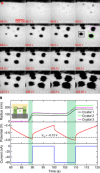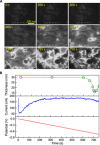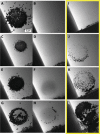Electrochemical electron beam lithography: Write, read, and erase metallic nanocrystals on demand
- PMID: 28706992
- PMCID: PMC5507638
- DOI: 10.1126/sciadv.1700234
Electrochemical electron beam lithography: Write, read, and erase metallic nanocrystals on demand
Abstract
We develop a solution-based nanoscale patterning technique for site-specific deposition and dissolution of metallic nanocrystals. Nanocrystals are grown at desired locations by electron beam-induced reduction of metal ions in solution, with the ions supplied by dissolution of a nearby electrode via an applied potential. The nanocrystals can be "erased" by choice of beam conditions and regrown repeatably. We demonstrate these processes via in situ transmission electron microscopy using Au as the model material and extend to other metals. We anticipate that this approach can be used to deposit multicomponent alloys and core-shell nanostructures with nanoscale spatial and compositional resolutions for a variety of possible applications.
Figures




Similar articles
-
Direct-write liquid phase transformations with a scanning transmission electron microscope.Nanoscale. 2016 Aug 25;8(34):15581-8. doi: 10.1039/c6nr04994j. Nanoscale. 2016. PMID: 27510435
-
Direct Patterning of Zinc Sulfide on a Sub-10 Nanometer Scale via Electron Beam Lithography.ACS Nano. 2017 Oct 24;11(10):9920-9929. doi: 10.1021/acsnano.7b03951. Epub 2017 Sep 26. ACS Nano. 2017. PMID: 28938068
-
Self-Assembled Framework Formed During Lithiation of SnS2 Nanoplates Revealed by in Situ Electron Microscopy.Acc Chem Res. 2017 Jul 18;50(7):1513-1520. doi: 10.1021/acs.accounts.7b00086. Epub 2017 Jul 6. Acc Chem Res. 2017. PMID: 28682057
-
Noble metal alloy complex nanostructures: controllable synthesis and their electrochemical property.Chem Soc Rev. 2015 May 21;44(10):3056-78. doi: 10.1039/c4cs00478g. Epub 2015 Mar 20. Chem Soc Rev. 2015. PMID: 25793455 Review.
-
Interfacially formed organized planar inorganic, polymeric and composite nanostructures.Adv Colloid Interface Sci. 2004 Nov 29;111(1-2):79-116. doi: 10.1016/j.cis.2004.07.005. Adv Colloid Interface Sci. 2004. PMID: 15571664 Review.
Cited by
-
Liquid cell transmission electron microscopy and its applications.R Soc Open Sci. 2020 Jan 15;7(1):191204. doi: 10.1098/rsos.191204. eCollection 2020 Jan. R Soc Open Sci. 2020. PMID: 32218950 Free PMC article. Review.
-
Real-time imaging of nanoscale electrochemical Ni etching under thermal conditions.Chem Sci. 2021 Feb 26;12(14):5259-5268. doi: 10.1039/d0sc06057g. Chem Sci. 2021. PMID: 34163761 Free PMC article.
-
Controlling the radical-induced redox chemistry inside a liquid-cell TEM.Chem Sci. 2019 Aug 16;10(38):8735-8743. doi: 10.1039/c9sc02227a. eCollection 2019 Oct 14. Chem Sci. 2019. PMID: 32133124 Free PMC article.
References
-
- I. Utke, S. Moshkalev, P. Russell, Eds., Nanofabrication Using Focused Ion and Electron Beams - Principles and Applications (Oxford Univ. Press, 2012).
-
- Mijatovic D., Eijkel J. C. T., van den Berg A., Technologies for nanofluidic systems: Top-down vs. bottom-up—A review. Lab Chip 5, 492–500 (2005). - PubMed
-
- Vieu C., Carcenac F., Pépin A., Chen Y., Mejias M., Lebib A., Manin-Ferlazzo L., Couraud L., Launois H., Electron beam lithography: Resolution limits and applications. Appl. Surf. Sci. 164, 111–117 (2000).
-
- Kim C.-S., Ahn S.-H., Jang D.-Y., Review: Developments in micro/nanoscale fabrication by focused ion beams. Vacuum 86, 1014–1035 (2012).
Publication types
LinkOut - more resources
Full Text Sources
Other Literature Sources

